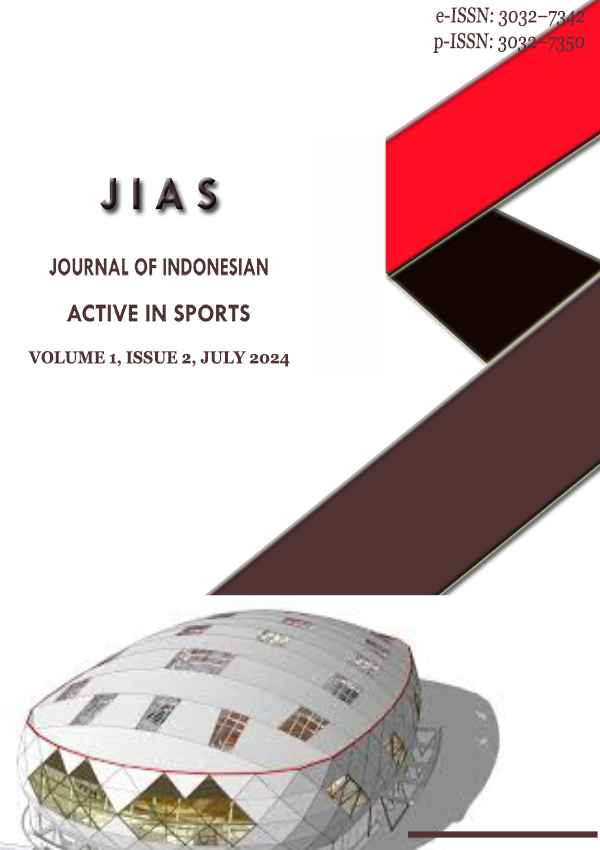Contribution of Ladder Drill and Dryland Circuit Training to 50-meter Freestyle Swimming Speed in 13-to-14 Male Swimmers Aquatic Swimming Club
DOI:
https://doi.org/10.24114/jias.v1i2.52473Abstract
The objective of this study was to assess the impact of ladder drill and dryland circuit exercises on the pace of 50-meter freestyle swimming in male swimmers aged 13-14 years at the Aquatic Swimming Club in Medan. The researchers employed an experimental approach utilising a pre-experimental design consisting of a single group with pretest and posttest measurements. The sample comprised 8 adolescent male swimmers, aged 13-14 years, who were actively involved in the club. They were recruited via purposive sampling. The study was carried out for a duration of 6 weeks, consisting of 18 training sessions, conducted 3 times a week. Measurements were obtained using 40-meter sprint tests, medicine ball throw tests, and 50-meter freestyle swimming speed tests conducted both before and after the training treatments. The data underwent analysis through normality tests, homogeneity tests, correlation tests, and regression tests. The findings demonstrated that ladder drill training made a noteworthy contribution of 59.29% to enhancing 50-meter freestyle swimming speed. Similarly, dryland circuit training had a substantial impact, accounting for 77.44% of the improvement. Furthermore, when both training methods were combined, they together contributed 62% to the enhancement of swimming speed. The study found that both ladder drill and dryland circuit training have a substantial impact on improving the 50-meter freestyle swimming speed of male swimmers aged 13-14 at the Aquatic Swimming Club in Medan. Additionally, the dryland circuit training was found to have a greater effect than the ladder drill.References
Amaro, N. M., Marinho, D. A., Marques, M. C., Batalha, N. P., & Morouço, P. G. (2017). Effects of Dry-Land Strength and Conditioning Programs in Age Group Swimmers. The Journal of Strength & Conditioning Research, 31(9), 2447-2454. doi:10.1519/jsc.0000000000001709
Arikunto, S. (2014). Prosedur Penelitian: Suatu Pendekatan Penelitian. Jakarta: Rineka Cipta.
Bishop, D. C., Smith, R. J., Smith, M. F., & Rigby, H. E. (2009). Effect of Plyometric Training on Swimming Block Start Performance in Adolescents. The Journal of Strength & Conditioning Research, 23(7), 2137-2143. doi:10.1519/JSC.0b013e3181b866d0
Crowley, E., Harrison, A. J., & Lyons, M. (2018). Dry-Land Resistance Training Practices of Elite Swimming Strength and Conditioning Coaches. The Journal of Strength & Conditioning Research, 32(9), 2592-2600. doi:10.1519/jsc.0000000000002599
Dinata, M., & Wijaya, T. (2006). Renang. Jakarta: Cerdas Jaya.
Haller, D. (1982). Belajar Berenang. Bandung: Pioner Jaya.
Nurhasan. (2001). Tes dan Pengukuran dalam Pendidikan Jasmani. Jakarta: Direktorat Jendral Olahraga.
Sadowski, J., Mastalerz, A., Gromisz, W., & Niźnikowski, T. (2012). Effectiveness of the power dry-land training programmes in youth swimmers. Journal of Human Kinetics, 32(2012), 77-86.
Sudjana. (2005). Metode Statistika. Bandung: Tarsito.
Sugiyono. (2017). Metode Penelitian Pendidikan: Pendekatan Kuantitatif, Kualitatif, dan R&D. Bandung: CV. Alfabeta.
Downloads
Published
How to Cite
Issue
Section
License
Copyright (c) 2024 James Dionisius Simbolon & Novita

This work is licensed under a Creative Commons Attribution-ShareAlike 4.0 International License.












